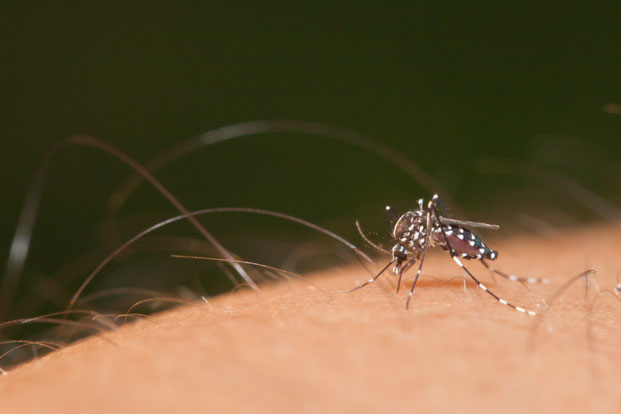They sound exotic, limited to far-off lands that you may not even be able to pinpoint without a map. Zika chikungunya dengue leishmaniasis occasionally we hear about these afflictions in the news, but they’re nothing to worry about if you live in the U.S., right?
Even if you’ve never ventured outside the continental United States, you’ll find “tropical” diseases are here, and they’ve made a home. The danger and risk of contracting a tropical disease is real and can be serious.
It’s not a new problem in the U.S., particularly the humid, mosquito-ridden Southeast and Southwest. Epidemics of yellow fever, dengue and malaria have occurred, frequently, even into the mid-20th century. In fact, the Centers for Disease Control and Prevention, based in Atlanta, was formed in 1946 specifically to combat malaria.
And instead of tropical diseases originating in another country, many are contracted from good, old American mosquitoes and other parasites. It’s so widespread in the South that clinics devoted to infectious diseases cater specifically to them. Infectious disease physician Peter Hotez formed such a clinic in Houston at the Baylor College of Medicine.
“While we were calling them neglected tropical diseases, the ‘tropical’ part is probably a misnomer,” Hotez told CNN. “Most of the world’s neglected tropical diseases are in wealthy countries. It’s the poor living among the wealthy.”
High rates of poverty, immigrants and humidity make the South a hotbed for tropical diseases.
Tropical Diseases: The Culprits
The types of pathogens more associated with “tropical” diseases are parasites – it so happens these are fairly common in the United States. The mosquitoes that carry dengue fever, chikungunya, malaria and yellow fever are prevalent in the United States.
Internationally, malaria is likely the most notorious “tropical” ailment, one that has been considered “foreign” to Americans. There are a set of four parasites that carry the disease, which is then transmitted by female mosquitoes. Symptoms include high fever, shaking chills and severe flulike symptoms, and the World Health Organization estimates nearly 200 million cases worldwide occur annually, with about 1,500 diagnosed in the United States. Worldwide, approximately half a million people who contract malaria annually will die.
Mosquitoes carry flaviviruses, which cause dengue fever and several other tropical diseases. Dengue causes flu-like symptoms and severe pain in the areas of the head, eyes, muscles and joints. Nearly 400 million cases occur worldwide, according to the CDC, but there are usually less than 100 cases found annually in the United States. The most recent outbreak has been ongoing in Hawaii for nearly six months. The island state has experienced 242 confirmed cases of dengue fever with no reported fatalities.
A flavivirus is also to blame for the headline-making Zika virus, which has been prominent in the news as it spreads in South and Central America. Particularly in Brazil, women of childbearing age have been advised to put off conception until the epidemic subsides. For those who have healthy immune systems, Zika causes mild fever, rash, conjunctivitis (pink eye) and muscle pain – or no symptoms at all. But in November 2015, the Ministry of Health in Brazil found a link in the uptick of babies born with microencephaly to Zika virus infections. Microencephaly is a serious condition in which infants exhibit a smaller-than-normal head circumference, which may accompany developmental delays and other serious complications. Experts recommend the same avoidance strategies for pregnant women in affected areas as anyone else trying to ward off mosquitoes.
Chikungunya is a difficult word to say and a disease that’s even more difficult to endure. Much like dengue, chikungunya causes debilitating pain. Its name, which means “that which bends up,” gives an idea of its effect on the joints. Since mid-2014, 497 travel-related cases have been found in the United States, primarily in the Southeast.
Tropical Disease Prevention
Much like the other mosquito-transmitted diseases, the best way to prevent chikungunya is to make the environment inhospitable to mosquitoes by eliminating sources of standing water and areas where water can collect, such as birdbaths, spare tires and kiddie pools. These areas are where mosquitoes like to lay their eggs. Spending time outdoors requires applying a DEET-based insecticide and wearing long pants and sleeves.
Socioeconomic conditions that give rise to these diseases seem to be those of neglect – inadequate drainage and waste management, where mosquitoes and other vectors (vector refers to an organism that carries an infectious pathogen) collect and proliferate. In many pockets of the southern United States, the heat and humidity, a crumbling infrastructure and concomitant problems – overcrowding, cross-contamination and stray animals – make a rampant recipe for disease.
An estimated 45 million Americans live in poverty, including more than one in five children. Approximately 1.65 million live in extreme poverty, defined as living on less than $2 per day, according to a study conducted by the National Poverty Center.
Clearly, early health care maintenance affects lifelong ability to ward off disease. Once they do invade, pathogens can remain dormant, stored in recesses of the body. Prevalent conditions such as diabetes, malnutrition, stress, cardiovascular disease and more can lower the body’s resistance to those pathogens. Couple that with a lack of preventive measures to eradicate mosquitoes, and it’s the perfect storm for once-tropical diseases to invade the borders. Poverty is our neighbor. Poverty is pernicious, its effects immeasurable, its ills cannot be exaggerated – at home and elsewhere.

Leave a Reply